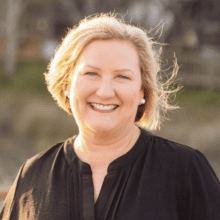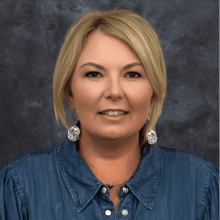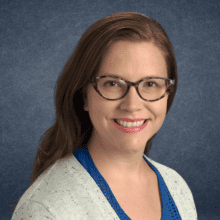Thanks to the vision of North Carolina state leaders and policymakers as well as dedicated funding from N.C. General Assembly, the N.C. Department of Public Instruction’s Office of Early Learning (OEL) has been able to build out multiple layers of collaborative support for North Carolina school districts to improve literacy.
This tiered coaching support now provided will ensure the long-term sustainability of Language Essentials for Teachers of Reading and Spelling (LETRS) professional development and implementation required in the 2021 Excellent Public Schools Act, also referred to as NC Read to Achieve.
Literacy facilitators focus on systemic fidelity of LETRS professional development aligned to the law and sustainability.
Early literacy consultants focus on regional implementation support and coaching.
Early literacy specialists focus on local implementation, support, and coaching.

Dare County Schools is one example of a district experiencing a positive systems shift, evidenced by educator knowledge, classroom instruction, and student growth outcomes achieved via the collaborative support model.
One opportunity for improvement in Dare was the intentional planning and restructuring of literacy instruction during summer reading camps. The district focused on developing a clear vision and systematic plan to utilize the Walk to Read framework aligned to student data.
A ‘Walk to Read’ framework refers to a differentiated instruction strategy used by the North Carolina Department of Public Instruction where students are grouped based on their reading skill level and ‘walk’ to different classrooms for targeted instruction on specific phonics and fluency skills, allowing for individualized learning within a small group setting; essentially, it’s a method to provide focused reading support based on each student’s needs by grouping them with similar skill levels and rotating them between teachers specializing in those skills.
With the combined support of the OEL regional literacy facilitator, regional literacy consultant, early literacy specialist, and district leaders, Dare has been able to turn this vision into reality.
The role of the regional literacy facilitator by Chris Shrock
As the Northeast literacy facilitator, I provide statewide Language Essentials for Teachers of Reading and Spelling (LETRS) professional development aligned to the Read to Achieve Act and NC Senate Bill 387. In this role, I also serve as the communication link between the Northeast regional literacy consultant and early learning specialists (ELS) in each district aiming to increase professional knowledge with the intent to establish a cohesive, sustainable science of reading implementation model across the region. This position is assigned to each region in North Carolina to support and sustain statewide consistency of aligned educational practices. We provide LETRS professional development, minimizing local cost, while also developing resources to support state and local facilitators with the intent to increase the fidelity of LETRS training and long-term sustainability for North Carolina.
My specific work with Dare County has allowed Rhys Lamberg, the early learning specialist, and me to collaborate and plan in-person LETRS professional development sessions for cohorts of teachers. We meet before each unit to plan opportunities for teachers to practice and internalize theories and instructional routines that will serve the individualized needs of students. This work has allowed us to maintain the alignment of LETRS, and therefore the Science of Reading, to the instructional practices teachers use each day in their classrooms. Our relationship is reflected in the sessions, as I am able to share expertise in the content while Rhys connects the meaningful learning to the curriculum used in Dare County.
The role of early literacy consultant by Karen Wood
As the regional early literacy consultant, I am afforded the opportunity to work with each district in the Northeast, coaching and supporting their early literacy specialists on effective literacy professional development, implementation, and sustainability. Each district develops an annual literacy intervention plan aligned to data outcomes, stakeholder feedback, local leadership priorities, and various initiatives.
Throughout the year, in collaboration with the district and the early literacy specialists, I spend time supporting and celebrating the implementation of local plans aligned to state legislation and policy. This position enables me to have a bird’s eye view of the region and provide varying levels of support to the specialists and districts based on data-driven needs and requests.
“They are challenging the status quo of ‘the way we have always done business.’”
Rhys Lamberg, the early learning specialist in Dare County Schools, has extensive content knowledge and coaching experience. She is a forward thinking educator who consistently focuses on what students will need to help develop literacy skills necessary for successfully accessing grade-level content. Her collaborative work with the district’s elementary director, Catie Spruill, has been nothing short of visionary, and they are challenging the status quo of “the way we have always done business.” They seek out new approaches to teaching and learning that are aligned to the body of research on the science of reading while simultaneously equipping teachers with the ability to utilize data to meet the varying needs of all students. One example of this is the district’s implementation of Walk to Read.
The role of early literacy specialist by Rhys Lamberg
It’s Feb. 12, 2024, and I am sitting in a conference center in Greensboro surrounded by more than 100 early literacy specialists, as well as the team members who lead, guide, and support literacy work being implemented in districts across the state.
Our guest speaker for the morning asks, “If we had a magic wand, how would reading instruction in our schools and districts change?”
My list is short, but includes some big asks:
- Teachers would be excited about what they are teaching.
- People would believe what our assessments are telling us, AND would know what to do with the information the assessments give us.
- Our school and grade-level meetings would shift from information-packed lists to learning about effective reading practices and practicing how to apply those practices within our classrooms.
- We would adopt the mindset that 95% of students can learn to read fluently.
The guest speaker for the day, Dr. Stephanie Stollar, went on to lead a session that resulted in six pages of notes in my notebook and a fire in my cheeks because I was so excited to talk to my district point of contact and find a team of teachers in my district who would be willing to try one of the frameworks Dr. Stollar discussed in her session.
One of her key phrases — “Tier 1 is risk reduction” — has lived on repeat in my mind and in discussions I’ve had over the last nine months. It means our first step as teachers is to increase the number of students who master grade level standards thereby decreasing the number of students who need interventions later on.
Before the end of the day, I was sending fervent texts to Catie Spruill that we had to find a way to pilot this approach to differentiate and accelerate reading development. Our teachers and children deserved it!
Walking into the Office of Early Learning Partnership in Practice gathering, I was a brand-new early literacy specialist trying to determine how to improve our supplemental and intensive support for foundational reading skills. We had interventionists in each building, but post-pandemic, the number of students who needed intervention was greater than we could feasibly meet, even through dedicated enrichment/intervention blocks and with the support of the amazing interventionists. I suspected we needed to adjust Tier 1 (core) instruction to meet most students where they were. Still, I had no idea how to do that without boring the students who already “get it” while ensuring student learning is being accelerated to close gaps.
Stoller’s key phrase felt like someone had opened the door to a completely different way of thinking about foundational literacy instruction, and I was ecstatic to take the new idea back to my district and get to work.
However, as with most wonderful experiences at conferences and professional learning opportunities, I faced many more questions and speed bumps as I ventured back to my district, eager to make this new idea fit into our context. My district point of contact was enthusiastic, and so were principals, but we all had many questions about how to make it work across our district and in our buildings.
Over the next couple of months, we explored the possibility of piloting the new framework in summer reading camp. As we worked through this idea, we connected with our early literacy consultant, Karen Wood, many times to double-check our plans and ensure we were aligned with best practices and legislation. Each time, I would wonder, “How does this framework impact XYZ?” Karen was always ready and available, helping us think through each piece while keeping the end in mind as we made small decisions throughout the planning process.
As we continued refining our plans for piloting Dare’s rendition of Walk to Read during summer reading camp, our literacy facilitator, Chris Shrock, supported the district through LETRS live unit sessions with our newest cohort of educators. Working alongside Chris during the sessions continued to increase my depth of knowledge and helped me ground my professional learning in research while connecting it to everyday application. The timeliness of this learning aligned perfectly with the development of our training for the summer reading camp instructional staff leading Walk to Read groups. It provided us with a means to balance the big picture “why” with the nuts and bolts we knew all staff would need to hit the ground running.
Implementing Walk to Read during 2024 summer reading camp was the spark that shifted the way we do literacy business in Dare County Schools. Currently, at least one grade level in all five elementary schools is implementing Walk to Read.
After only one month of implementation, we could see the difference in our initial data. While we realize this is only the beginning, we have audacious goals for where this framework will take us.
In under one year, we have been able to implement a completely new way of delivering Tier 1 and Tier 2 foundational skills instruction; this framework not only differentiates Tier 1 instruction but also maximizes active learning time for all students by ensuring they receive direct, targeted instruction that aligns with their specific academic needs.
The scale of this instructional transformation in such a short time is truly inspiring. I firmly believe that the right professional learning, delivered by the right people, at the right time, and supported with the right resources has been the driving force behind this change.
DPI’s Office of Early Learning has worked collaboratively, tirelessly, and intentionally to plan, support, and design every step of this process.
I’m deeply humbled to work alongside a team that collaborates so effectively, from the OEL leadership who invest in our growth, to the literacy facilitators who build our content knowledge, to the regional consultants who show up to guide us and answer our questions, as well as the early literacy specialists who help us brainstorm creative solutions.
Most of all, I’m incredibly grateful for every teacher, instructional assistant, principal, assistant principal, support staff, and district leader who has contributed to this shift for our students.
We are on the path to achieving reading success for every student.








